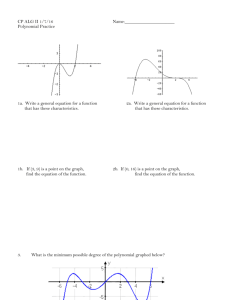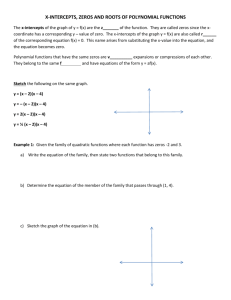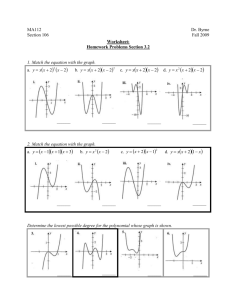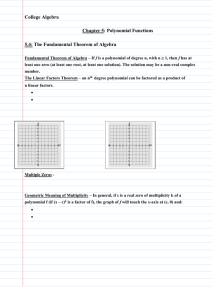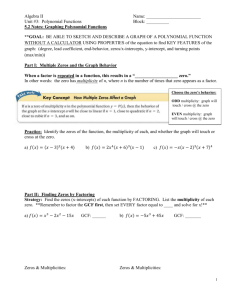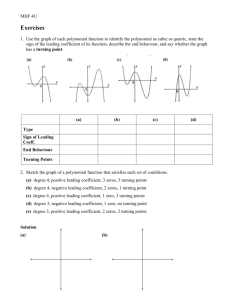2.2: Polynomial Graphs – Self
advertisement
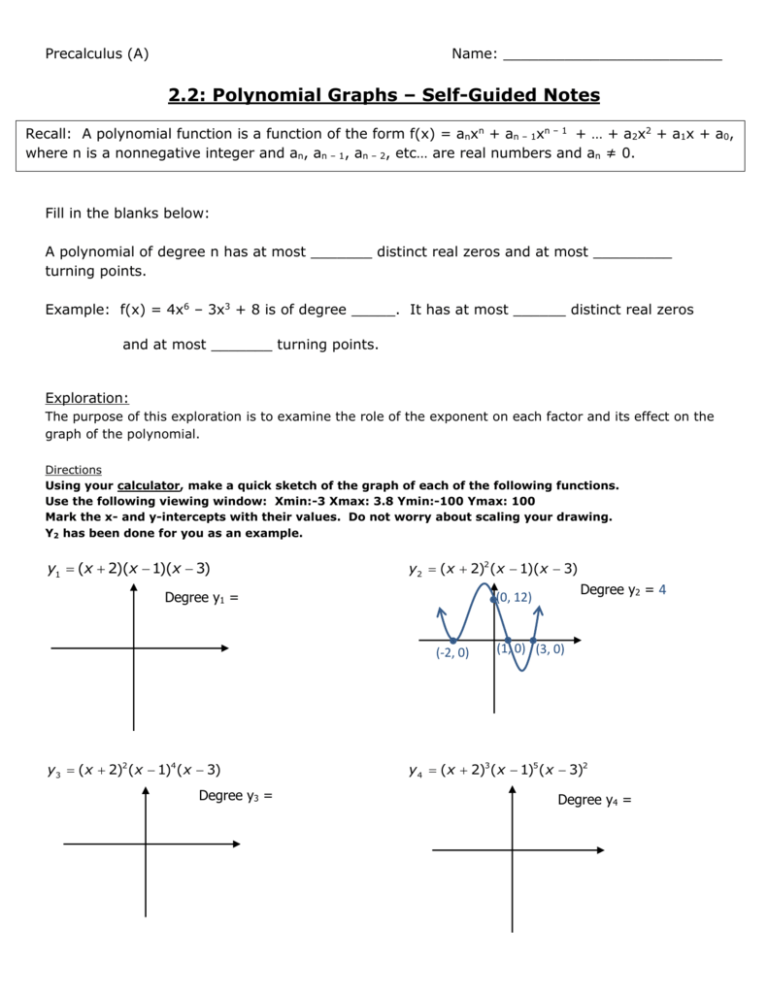
Precalculus (A) Name: _________________________ 2.2: Polynomial Graphs – Self-Guided Notes n–1 2 Recall: A polynomial function is aisfunction of the form f(x)f(x) = a=nxann+ Recall: A polynomial function a function of the form xn a+n –a1nx– 1xn –+1 … ++ … a+2xa2+ x2 a+1xa+ 1x a0, where is a nonnegative integer and an, aand real numbers and an ≠and 0. an ≠ 0. n – 1,aa + a0n, where n is a nonnegative integer , –a2n,–etc… are real numbers nn 1, an –are 2, etc… Fill in the blanks below: A polynomial of degree n has at most _______ distinct real zeros and at most _________ turning points. Example: f(x) = 4x6 – 3x3 + 8 is of degree _____. It has at most ______ distinct real zeros and at most _______ turning points. Exploration: The purpose of this exploration is to examine the role of the exponent on each factor and its effect on the graph of the polynomial. Directions Using your calculator, make a quick sketch of the graph of each of the following functions. Use the following viewing window: Xmin:-3 Xmax: 3.8 Ymin:-100 Ymax: 100 Mark the x- and y-intercepts with their values. Do not worry about scaling your drawing. Y2 has been done for you as an example. y1 (x 2)(x 1)(x 3) y2 (x 2)2 (x 1)(x 3) Degree y1 = (-2, 0) y3 (x 2)2 (x 1)4 ( x 3) Degree y3 = Degree y2 = 4 (0, 12) (1, 0) (3, 0) y 4 (x 2)3 (x 1)5 (x 3)2 Degree y4 = Under what circumstances did you find a “pass through” point? “Pass through would look like either of these: or Under what circumstances did you find a “bounce” point? By “bounce” we mean it looks like this: The degree of a factor of a polynomial is called the multiplicity of the factor. For each function y1 through y6, state each zero along with its multiplicity. *Example: y1: -2 has multiplicity 1, 1 has multiplicity 1, 3 has multiplicity 1. Y2:__________________________________________________ Y3:__________________________________________________ Y4:__________________________________________________ Examples: For each polynomial that follows: a) determine the end behavior by using limits b) determine the zeros and their multiplicities (factor if you need to) c) find the y-intercept and sketch a possible graph 1) f ( x ) x x 1 2 x 4 2) g(x ) x 1 2 x 3 2 x 3 Example 3: For each polynomial that follows: a) determine the end behavior by using limits b) determine the zeros and their multiplicities (factor if you need to) c) find the y-intercept and sketch a possible graph 3) h(x) 3x 3 6x 2 3x Questions 4 & 5: Find a polynomial function of degree n with only the following real zeros. (More than one answer is possible) 4) real zeros: -5, 4; n = 4 5) real zeros: 2, 1, 4; n = 5 Questions 6 – 8: Define a function of least degree that satisfies the conditions. (it may help to sketch the graph first) 6) zeros: -3, -1, 3 2 turning points y-intercept is (0, -45) 7) zeros: -3, 1, 5 3 turning points concave up on (-∞, 1) (4, ∞) concave down on (1, 4) lim f (x) , lim f (x) x 8) (0, 6) x


